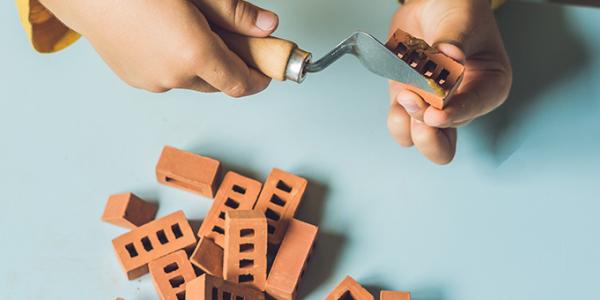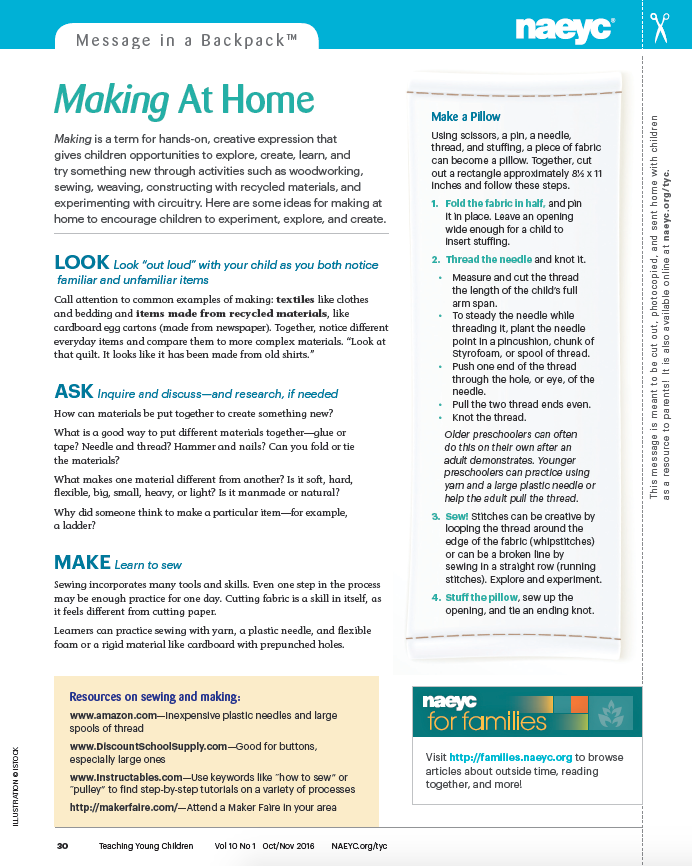Message in a Backpack™ Making at Home

You are here
Making is a term for hands-on, creative expression that gives children opportunities to explore, create, learn, and try something new through activities such as woodworking, sewing, weaving, constructing with recycled materials, and experimenting with circuitry. Here are some ideas for making at home to encourage children to experiment, explore, and create.
LOOK
Look “out loud” with your child as you both notice familiar and unfamiliar items
- Call attention to common examples of making: textiles like clothes and bedding and items made from recycled materials, like cardboard egg cartons (made from newspaper). Together, notice different everyday items and compare them to more complex materials. “Look at that quilt. It looks like it has been made from old shirts.”
ASK
Inquire and discuss—and research, if needed
- How can materials be put together to create something new?
- What is a good way to put different materials together—glue or tape? Needle and thread? Hammer and nails? Can you fold or tie the materials?
- What makes one material different from another? Is it soft, hard, flexible, big, small, heavy, or light? Is it manmade or natural?
- Why did someone think to make a particular item—for example, a ladder?
MAKE
Learn to sew
- Sewing incorporates many tools and skills. Even one step in the process may be enough practice for one day. Cutting fabric is a skill in itself, as it feels different from cutting paper.
- Learners can practice sewing with yarn, a plastic needle, and flexible foam or a rigid material like cardboard with prepunched holes.
Make a Pillow
Using scissors, a pin, a needle, thread, and stufing, a piece of fabric can become a pillow. Together, cut out a rectangle approximately 8½ x 11 inches and follow these steps.
-
Fold the fabric in half, and pin it in place. Leave an opening wide enough for a child to insert stufing.
-
Thread the needle and knot it.
Measure and cut the thread the length of the child’s full arm span.
To steady the needle while threading it, plant the needle point in a pincushion, chunk of Styrofoam, or spool of thread.
Push one end of the thread through the hole, or eye, of the needle.
Pull the two thread ends even.
Knot the thread.
Older preschoolers can often do this on their own after an adult demonstrates. Younger preschoolers can practice using yarn and a large plastic needle or help the adult pull the thread.
-
Sew! Stitches can be creative by looping the thread around the edge of the fabric (whipstitches) or can be a broken line by sewing in a straight row (running stitches). Explore and experiment.
-
Stuff the pillow, sew up the opening, and tie an ending knot.
Resources on sewing and making:
www.amazon.com—Inexpensive plastic needles and large spools of thread
www.DiscountSchoolSupply.com—Good for buttons, especially large ones
www.Instructables.com—Use keywords like “how to sew” or “pulley” to find step-by-step tutorials on a variety of processes
http://makerfaire.com/—Attend a Maker Faire in your area
